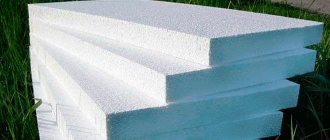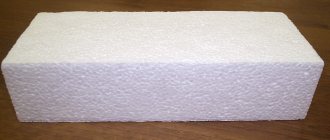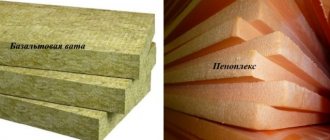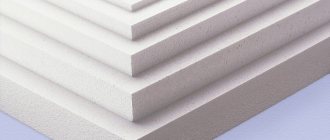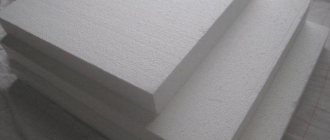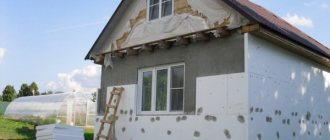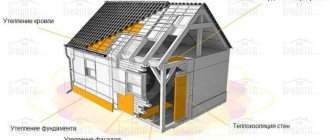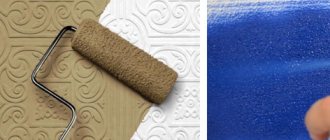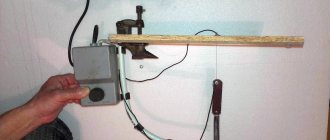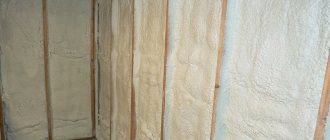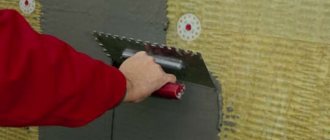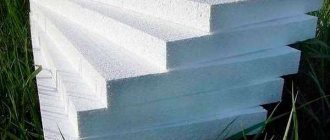Popular mistakes and misconceptions
Widespread errors and numerous misconceptions in the evaluation of expanded polystyrene foam do not allow us to correctly consider the characteristics of these materials and correctly determine the scope of their application:
- the insusceptibility of both insulation materials to combustion is a common myth. Of course, heavily foamed insulation burns much better, which is due to the presence of a large amount of air in the structure, but so-called self-extinguishing polystyrene foams, well impregnated with fire retardant, are also produced. Such a self-extinguishing material practically does not burn, but smokes heavily, releasing toxic materials;
- It is generally accepted that both materials have a unique, incomparable, very low thermal conductivity. As practice shows, penoplex has better, but not at all unique, thermal conductivity, for example, compared to the fairly popular and “light” mineral wool;
- the statement that they are practically eternal materials is considered practically true. However, it must be remembered that the molecular structure of any polystyrene foam is strongly damaged by many factors, such as heat, air, sunlight and radiation;
- expanded polystyrene practically does not absorb water and tolerates about fifty cycles of freezing and thawing, but even very high-quality polystyrene foam is less breathable, which must be taken into account when choosing the scope of application;
- both types of insulation are often used for the purpose of sound insulation, which is absolutely wrong. Such materials are completely incapable of blocking noise, so sound penetrates unhindered.
Wall insulation elements
As practice shows, high-quality polystyrenes and any products made from such materials are safe if they are manufactured in accordance with technological requirements and do not contain harmful impurities.
Before purchasing one of these insulation materials, you must make sure that the material is not impregnated with toxic fire retardants, which are dangerous to human health and cannot be used in residential premises.
What is better to use - polystyrene or polyurethane
If you know the difference between polyurethane and polystyrene , it is easier to choose what to use in each specific case.
Stucco molding
Stucco is made from gypsum , polyurethane and foam . Gypsum is a natural and environmentally friendly material , but it is afraid of moisture. It cannot be used in rooms with high humidity; it will crack and crumble.
The most accessible method is stucco foam . But it won't be very durable. Color a polystyrene product using spray paint. Polystyrene foam is easy to install.
It is even better to choose duropolymer for . It is moisture and wear resistant and easy to work with. But polyurethane can be used to make even more durable stucco molding , as well as columns, shelves, and consoles. Compared to polystyrene, polyurethane stucco has a clear pattern and a smooth surface. It can be painted with any paint. But polyurethane decoration will be more expensive.
Skirting boards
Experts advise using foam ceiling skirting boards . material for the floor , because it is easy to push through. It is better to use foam products where there is no contact with people, animals and furniture. The lightness of polystyrene ensures ease of installation. In addition, polystyrene skirting boards are very affordable. They will hide uneven joints between the ceiling and the wall well, and are also quite flexible. For the floor, it is better to use polyurethane skirting boards because they are resistant to mechanical stress and are easy to clean with a cloth and water .
Flexible polyurethane skirting boards are a good option for curved surfaces .
Properties of materials
Advantages of penoplex.
Both materials can be easily set on fire. However, lighter polystyrene foam belongs to the category of normally flammable materials (G3), and dense foam plastic belongs to the category of highly flammable building materials (G4). Manufacturers eliminate the inherent disadvantage of plastics by treating polystyrene foam with fire retardants, which makes them more resistant to fire. But the result of treatment with fire retardants was a deterioration in the environmental performance of the materials: they became self-extinguishing and began to release toxic substances into the atmosphere.
Foam plastic and penoplex are considered almost eternal materials. Their manufacturers emphasize this, but the statement about an unlimited resource can only be partly true, since expanded polystyrene foams are sensitive to such factors as environmental influences. They themselves need protection from ultraviolet radiation, temperature changes, air chemistry, etc. Therefore, it should be noted that penoplex or foam plastic can show their effectiveness only after they are covered with other materials. By the way, sufficient insulation from external influences is provided by a layer of plaster applied to polystyrene foam.
Advantages of polystyrene foam.
An important factor that allows the material to be used when insulating surfaces located in an environment with high humidity is the high moisture resistance of penoplex. Mineral wool, which is superior to this polystyrene foam in terms of noise and heat insulation, is completely unsuitable for laying on a plinth or foundation. Due to its properties, penoplex is practically airtight. In contrast, polystyrene foam cannot serve as a reliable barrier to free air circulation.
Having examined the characteristics that foam plastic and penoplex have, we can conclude that the differences between both materials lie in the degree of their strength, moisture resistance and breathability. The main differences between one material and another can be listed in a short list. Penoplex:
- more dense, which worsens the thermal insulation properties;
- moisture resistant;
- more flammable without special treatment;
- less environmentally friendly (as a result of treatment with fire retardants).
At the same time, polystyrene foam:
- less dense;
- retains heat better due to its friability;
- because of it, it protects less well from moisture;
- does not isolate from noise;
- effective only when covered with denser materials.
In other respects, both are approximately equal. Expanded polystyrene is easy to transport, process, and install. Builders must take all these circumstances into account before finding the most suitable application for materials.
Scope of materials
Polystyrene foam and expanded polystyrene can be used to insulate buildings - in general, their scope of use is quite similar. An additional advantage is ease of installation and adjustment, resistance to shrinkage. However, expanded polystyrene is a more popular insulation material. It has lower thermal conductivity and resistance to water, better strength. Therefore, it can be used to insulate any surfaces, including floors.
The foam begins to crumble even under slight loads. Rodents love it; they can make a whole network of tunnels in the insulation, reducing the thermal insulation ability. Therefore, it is better to use it for insulating walls and ceilings in houses and apartments where active pest control is carried out.
Penoplex and polystyrene foam: what is the difference?
Production
Both materials are made from polystyrene, but the production process is completely different:
When polystyrene granules are treated with steam, their volume increases almost fifty times and they stick together. The result is an airy material with micropores and voids between the granules.
If they are pressed well, then the density of such foam is high, and accordingly, the quality characteristics increase. Another name for the material is expanded polystyrene.
Manufactured by extrusion. Under conditions of high temperature and high pressure, a material appears that has a very uniform, dense structure with good consistency. The material is otherwise called extruded polystyrene foam.
Penoplex is much denser than polystyrene foam; accordingly, it weighs more, so it can withstand greater loads.
Thermal conductivity
Since the foam granules foamed during the production process do not fit too tightly to each other, its properties as a heat insulator are much lower than those of penoplex.
The latter has much smaller pores, since the material is much more compressed.
For an equal degree of protection from the cold, you will have to purchase 25 percent more polystyrene foam than polystyrene foam.
Moisture permeability and vapor permeability
Penoplex is more moisture resistant. Its degree of water absorption is approximately 0.35 percent, versus two percent for polystyrene foam. Although foam granules do not absorb water, it is quite capable of penetrating into the spaces between them. As a result, the foam may become slightly saturated with a small amount of moisture. Polystyrene foam is more vapor permeable than penoplex insulation, in which this indicator is reduced to almost zero. In principle, both materials have an extremely low degree of vapor permeability.
Strength
Polystyrene foam is more fragile because it consists of small particles that are connected to each other; it crumbles easily due to a small force.
Penoplex is almost six times stronger and is extremely difficult to break. In addition, polystyrene foam is afraid of kinks, it breaks, its analogue bends much better. If we compare the indicators of materials in terms of compressive strength, then they are incomparably higher for foam plastic.
Service life and processing capability
Both of these thermal insulators are durable, however, penoplex has a longer service life. Over time, the foam begins to crumble. But in order for both materials to serve for a long time, they must be protected from direct sunlight, as well as from other atmospheric influences.
Both polystyrene foam and polystyrene foam can be cut with a regular knife, although polystyrene foam must be cut much more carefully, it can break because it is fragile. This is especially true for three-centimeter sheets.
Polystyrene foam is much cheaper than polystyrene foam, this must be taken into account if the cost part of your project is of great importance. For example, one cubic meter of polystyrene foam is more than one and a half times cheaper than its competitor, for this reason, when constructing buildings, the first option is often chosen: the cost of housing is significantly reduced
For example, one cubic meter of polystyrene foam is more than one and a half times cheaper than its competitor, for this reason, when constructing buildings, the first option is often chosen: the cost of housing is significantly reduced.
Features and differences of production
The production of polystyrene foam and expanded polystyrene is carried out in two different ways. What determines their first difference between each other. In addition, depending on the production method, each material has a number of characteristics acquired during the process.
The production of polystyrene foam occurs by treating polystyrene granules with water vapor. Due to this processing, grains of material increase in volume and begin to stick together, forming a single porous fabric.
Expanded polystyrene is produced using extrusion technology. That is, first the granules undergo heat treatment, as a result of which they melt and acquire an almost uniform structure, then the resulting mass is treated with hot steam and the result is expanded polystyrene foam with micropores of a homogeneous organization.
Features or characteristics that will help when choosing a particular material include the following:
- Water absorption. For example, for polystyrene foam this indicator is higher than for expanded polystyrene and is equal to 4.
- Thermal conductivity. Expanded polystyrene has better thermal conductivity, that is, it is also more economical, because, using it as insulation, its thickness can be adjusted, and it may not be so large.
- Tensile strength. Shows how strong and durable the material is. This figure is higher for expanded polystyrene.
- Compression limit. This figure is also higher for expanded polystyrene.
- Density. Following the logic and the above described methods of production of materials. The density will be higher again for the same polystyrene foam.
- Operating temperatures. This is one of the few indicators in which the materials are similar. They can operate from -50 degrees Celsius to +75 degrees Celsius.
- Life time. Expanded polystyrene is more durable. This is due to its high strength and compressive strength limits.
These are not all the characteristics by which you can choose a material.
Properties of expanded polystyrene
This thermal insulation material has been known in Europe for more than 50 years. Its popularity is explained by the presence of closed pores, where the use of freon is not expected, as well as low cost of production. You can purchase extruded polystyrene foam at any building materials store. Despite its low cost, it has high thermal insulation efficiency.
Polystyrene foam consists of air bubbles, frozen foam. This is where the name Expanded Polystyrene comes from.
The differences lie in a completely new production method and a more modern material base.
The original foam is not permeable to steam, but it can absorb moisture up to 4%. Expanded polystyrene practically does not absorb water due to its density. But the improved waterproofing properties do not prevent this material from breathing. This happens due to the molding method; extruded polystyrene foam Penoplex is molded by cutting. The strength of this insulation is much higher due to the production method using extruders. The molecular bonds in this material are several times higher than in simple foam.
The fire safety of Penoplex is due to the addition of fire retardants to it. These are special substances that prevent the material from catching fire. Like any polymer, foam will burn if it can be set on fire. This is prevented by high resistance to sunburn. Its biological stability is also high. Molds cannot live on polymers.
It is necessary to take into account a number of properties that polystyrene foam cannot provide:
- Low noise absorption ability. The rigid cells of insulated air act as resonators rather than sound dampers.
- Expanded polystyrene is not resistant to aggressive environments. He is afraid of acetone, varnishes, drying oil and turpentine. But it does not react with bitumen, soap and mineral fertilizers.
- In the heat, the foam oxidizes. While it is impossible to carry out complete polymerization of the components in production, harmful substances will be released when exposed to high temperatures.
What is insulated with foam plastic
EPS is the warmest.
The internal structure of the foam does not allow steam to pass through well, so condensation forms inside the room
Polystyrene foam is not suitable for internal insulation because it is not capable of convecting air and has low vapor permeability. This can lead to the fact that heat stops flowing to the desired surface, and the dew point moves inside the structure. This is the best and most cost-effective option for external insulation. Scope of application:
- roofing and attic structures;
- foundations, especially strip type;
- loggias and balconies;
- industrial and agricultural premises;
- cooling units.
Mineral wool slabs retain sound waves, but the denser the material, the greater the sound permeability
It is advisable to use mineral wool in cases where polystyrene foam cannot be used. It is chosen for insulating houses and structures made of wood, since foam plastic cannot allow air and moisture to pass through, causing damage to the structure. Mineral wool works most effectively in rooms exposed to high temperatures.
When it is necessary to insulate warehouses or structures for storing flammable or combustible substances, mineral wool insulation is an excellent choice. The material is also suitable for those who want to create good sound insulation in the room in addition to thermal insulation. It practically does not allow sounds to pass through due to its composition and dense texture.
We invite you to familiarize yourself with: Do-it-yourself stone stove for a bathhouse
Quite often, polystyrene foam is used where there is high humidity. Polystyrene foam is used for many tasks:
- Even when in contact with wet soil, the foam will not lose its characteristics. This allows the material to be used for insulating foundations. After many decades, the insulation will have the same characteristics as during installation. The foundation with such insulation is reliable and durable.
- If the house is being built on a monolithic foundation, using polystyrene foam is quite beneficial. The insulation boards are laid on a flat area. They are filled with concrete on top.
- To prevent freezing of the foundation, it is better to lay the insulation both horizontally and vertically. Lay the slabs along the base. Afterwards, they need to be covered with a layer of waterproofing. This method of insulation allows you to reliably protect the foundation of the house from frost.
- If the walls of the house are made of foam blocks or bricks, insulating them with foam plastic is the optimal solution.
- Expanded polystyrene is often used when it is necessary to insulate non-ventilated roofs. Waterproofing is laid on top. Cold ventilated roofs use a different thermal insulation method. In this case, space for ventilation must be left. This allows you to get rid of condensation.
- Floors are often insulated with polystyrene foam. It is necessary to lay insulating material under the slabs. The insulation slabs are poured with concrete on top.
Such areas of application of polystyrene foam indicate its reliability and efficiency. The material has gained popularity not only in the construction industry, but also among craft lovers.
What is better for insulation - polystyrene foam or extruded polystyrene foam?
Foam sheets are characterized by increased surface capillarity. This means that some of the moisture in the form of vapor can accumulate inside the near-surface layer of insulation. Therefore, low-density foam insulation today remains the only type of thermal insulation that can be used to insulate walls, ceilings and floors from the inside of a room.
In addition, the foam surface has increased adhesion to various types of screeds, self-leveling floors and plasters. Therefore, foam plastic is widely used for insulation under cladding with vapor-permeable materials.
The strength of foam sheets is sufficient to attach insulation to walls mechanically
In general, the choice of whether to insulate walls with polystyrene foam or expanded polystyrene largely depends on where the thermal insulation will be laid.
Expanded polystyrene is extremely resistant to conditions of strong contact pressure, watering and large temperature differences. Therefore, any type of insulation of non-residential premises, dachas with irregular heating, concrete floors for garages, roofs and facades of buildings are made using extruded thermal insulation grades.
Foam insulation will require protection from sunlight, while polystyrene foam sheets can last for several seasons without cladding
Selection of material by area of use
Quite often, modern developers wonder what is better - penoplex or polystyrene foam for insulation. To solve this problem, it is necessary to decide on which part of the building the material will be installed. For example, for a façade it is best to choose polystyrene foam, since it is cheaper and can allow air to pass through. This choice will reduce the cost of vapor barrier, because the wall will not lose its ability to breathe. For internal insulation of a house, it is best not to use such materials, although they themselves are environmentally friendly, they can be impregnated with special solutions. The latter emit toxic substances during operation.
If you are thinking about what is the best way to insulate a house - polystyrene foam/penoplex - then the latter option is better to choose for loggias or balconies. It has lower thermal conductivity and does not reduce the internal space as much. But if you have a flat roof and need to insulate it, both options are suitable. The ceiling can also be thermally insulated with any material of your choice. However, this decision is justified if you do not plan to walk through the attic afterwards. Otherwise, it is best to choose penoplex. Both materials are suitable for floor insulation, but it is better to make the rough surface using joists.
Definition
Foam plastic is a group of materials that are plastic masses made by foaming. The starting materials in this case are polymers.
Styrofoam
Expanded polystyrene is a gas-filled material made from polystyrene. Sometimes, depending on its purpose, styrene copolymers are used for production. Both substances are used in the construction industry. In this case, expanded polystyrene can be used as packaging and electrical insulating material.
Expanded polystyrene
Properties of materials
Advantages of penoplex.
Both materials can be easily set on fire. However, lighter polystyrene foam belongs to the category of normally flammable materials (G3), and dense foam plastic belongs to the category of highly flammable building materials (G4). Manufacturers eliminate the inherent disadvantage of plastics by treating polystyrene foam with fire retardants, which makes them more resistant to fire. But the result of treatment with fire retardants was a deterioration in the environmental performance of the materials: they became self-extinguishing and began to release toxic substances into the atmosphere.
Foam plastic and penoplex are considered almost eternal materials. Their manufacturers emphasize this, but the statement about an unlimited resource can only be partly true, since expanded polystyrene foams are sensitive to such factors as environmental influences. They themselves need protection from ultraviolet radiation, temperature changes, air chemistry, etc. Therefore, it should be noted that penoplex or foam plastic can show their effectiveness only after they are covered with other materials. By the way, sufficient insulation from external influences is provided by a layer of plaster applied to polystyrene foam.
Advantages of polystyrene foam.
An important factor that allows the material to be used when insulating surfaces located in an environment with high humidity is the high moisture resistance of penoplex. Mineral wool, which is superior to this polystyrene foam in terms of noise and heat insulation, is completely unsuitable for laying on a plinth or foundation. Due to its properties, penoplex is practically airtight. In contrast, polystyrene foam cannot serve as a reliable barrier to free air circulation.
Having examined the characteristics that foam plastic and penoplex have, we can conclude that the differences between both materials lie in the degree of their strength, moisture resistance and breathability. The main differences between one material and another can be listed in a short list. Penoplex:
- more dense, which worsens the thermal insulation properties,
- moisture resistant,
- more flammable without special treatment,
- less environmentally friendly (as a result of treatment with fire retardants).
At the same time, polystyrene foam:
- less dense
- retains heat better due to its friability,
- because of it, it protects against moisture worse,
- does not isolate from noise,
- effective only when covered with denser materials.
In other respects, both are approximately equal. Expanded polystyrene is easy to transport, process, and install. Builders must take all these circumstances into account before finding the most suitable application for materials.
What to look for when choosing
Extruded polystyrene foam Penoplex is produced in the form of slabs of various markings - Penoplex 35, 31, 31С, 45С, 45, 75. Moreover, recently the marking of slabs 35, 31, 31С has been replaced by new types:
- 35 (without fire retardants) - Penoplex-Foundation;
- 35 — Penoplex-Roof;
- 31 - Penoplex-Wall;
- 31C - Penoplex-Comfort.
The average consumer is unlikely to be interested in super-dense slabs marked 45C, 45, 75 to solve pressing insulation problems.
Plates with increased strength are used for thermal insulation of load-bearing structures of buildings and structures, road surfaces, for loaded structures and airfield runways. The thickness of the slabs is 40, 50, 60, 80 and 100 mm, and the size is 600 by 2400 mm.
Therefore, the question of choosing between the materials expanded polystyrene and penoplex 45 or 75 is raised only on an industrial scale.
An ordinary buyer, as a rule, needs to choose one of two options - expanded polystyrene or penoplex 35? Or, in light of the latest innovations from the penoplex manufacturer - Penoplex-Foundation, Penoplex-Roof, Penoplex-Wall and Penoplex-Comfort.
The new labeling of thermal insulation boards speaks for itself here. Extruded polystyrene foam or Penoplex 35 is divided by the manufacturer into two types - without the use of special treatment to reduce flammability for Penoplex-Foundation and with impregnation with fire retardants for Penoplex-Roofing.
Expanded polystyrene Penoplex-Comfort is the most versatile brand of material. The slabs are used for thermal insulation of balconies and loggias, roofs, walls, plinths, foundations and floors, as well as insulation of garages and outbuildings.
The almost complete waterproofness of the slabs makes it possible to use them for thermal insulation of bathhouses, saunas and swimming pools with high levels of humidity. The thickness of the slabs is 20, 30, 40, 50, 60, 80 and 100 mm, and the size is 600 by 1200 mm.
Prices
The production of both expanded polystyrene and penoplex is quite cheap. What is their retail price?
The price of extruded polystyrene foam and penoplex with the most minimal parameters (density, thickness, quantity per package) starts from 1000 rubles, respectively. and 1200 rub. per package. Conclusion - the brand name of various manufacturers also matters when choosing and purchasing insulation.
Penoplex turned out to be the most expensive insulation among all brands of extruded polystyrene foam. And with an increase in the characteristics of heat-insulating boards of different brands, the price correspondingly increases further - up to 3,000 rubles. and 4200 rub.
The cost of expanded polystyrene (foam) also depends on the physical characteristics and manufacturer and is in the range of 1000 - 3000 rubles. per package. The price of penoplex and expanded polystyrene on the building materials market is slightly different in favor of the latter.
The small price difference between expanded polystyrene and penoplex is most likely due to the more complex manufacturing technology of penoplex. or maybe the seller’s trade markup is too high.
Your choice of good insulation
When the question arises about choosing insulation for a home, an ignorant person, when searching for options, comes across many discrepancies. Commercial offers on the Internet are replete with different terms. Polystyrene foam, as the general name for many insulation materials, is widely used in advertising by many suppliers. Let's take a closer look - Penoplex or expanded polystyrene?
The technology of combining the mixing of molten polymer components with the injection of a steam generator into it, called direct carbonation extrusion, was developed in the United States half a century ago. The development of technology, the development of new, more modern extruders, and the use of improved materials and components have led to the fact that extruded polystyrene foam is produced in several countries. Penoplex is produced in Russia from general-purpose polystyrene using a foaming agent based on light freons with an admixture of carbon dioxide. These freons are ozone-safe, non-flammable and non-toxic.
Penoplex is the most popular type of extruded polystyrene. Penoplex is available in the form of special mats. It has many advantages, of which it is worth highlighting moisture resistance and the ability to retain its original properties even under adverse external influences. This material is widely used as a good thermal insulator for foundations and roofs, as well as for finishing wall surfaces.
The brands of Penoplex produced differ in their intended purpose. The characteristics of each brand correspond to certain production standards and meet a specific purpose of use. Below is a comparison of the properties of the two most popular brands of Penoplex.
| № p/p | Characteristics of properties | Unit | Penoplex brand | |
| 35 | 50 | |||
| 1. | Density | Kg/m3 | 29,5 – 38,5 | 38,6 — 50 |
| 2. | Compressive strength | MPa | 0,25 | 0,5 |
| 3. | Static bending strength | MPa | 0,4-0,9 | 0,4-0,7 |
| 4. | Thermal conductivity coefficient (at 25 C°) | 0,028 | 0,03 | |
| 5. | Operating temperature range | С° | — 50 +75 |
Briefly, these brands can be characterized by their purpose.
Penoplex 35
Penoplex 35 is produced for use in construction, including housing. The main goal is thermal insulation of buildings and structures. During production, a fire retardant is introduced into it to increase resistance to fire.
The uniqueness of these additives is that when burning Penoplex 35 emits only CO2 and CO gases, similar to burning wood, which shows its high environmental safety. The size of the produced slabs is also dictated by ease of use in construction. Width 600 mm, length 1200 mm. The thickness of the slabs varies from 23 mm to 100 mm with a gradation of 20 mm. For insulation of foundations, this brand can be produced without fire retardant additives in order to reduce the cost.
Penoplex 50
Penoplex 50 is characterized by increased compressive and bending strength. This brand is used for thermal insulation of road surfaces, runways, and railways. Can be used for insulation of building foundations and basement floors, as well as existing roofs. It is in this brand that qualities such as resistance to wetting and operational durability are most in demand. Environmental requirements are lower; the requirements for density and strength of the material come to the fore. This brand is more often advertised under its production name expanded polystyrene Penoplex 45, which can withstand loads of up to 50 tons per 1 m2.
Scope of application of polystyrene foam and expanded polystyrene
Considering that polystyrene foam is the same polystyrene foam, but of higher density, its use in construction is mainly limited to insulating structural elements of buildings and structures. For example, non-pressed polymer material is quite often used for insulating facades, given its high thermal insulation properties and adhesion ability.
Roof insulation with polystyrene
But penoplex is good for insulating basement, foundation and basement elements of buildings, loggias and balconies. With a smaller thickness, it retains all the thermal insulation properties inherent in thicker foam.
At the same time, it is not recommended to carry out insulation with these materials indoors, especially residential ones, due to the fact that during production the insulation is treated with fire-retardant compounds, which can be released into the environment throughout its operation. In some countries in Europe and America, the use of polystyrene foam as a thermal insulation material is not permitted. The reason is the release of toxic substances during a fire.
Base insulation
Extruded polystyrene foam is used in the production of decorative interior products.
Polystyrene tiles as a finishing material in the interior of premises
In the medical industry, expanded polystyrene, just like polystyrene foam, is used as a material for making packaging.
These materials serve as insulation in household appliances, industrial refrigerators, they are used to make buoys, floats, life jackets, and they are used to fill the compartments of ships, which ensures their ability to float on the water.
In the food industry, packaging for products and fragile items is made from extruded polystyrene foam.
Foam plastic in the production of food packaging
Polymer materials obtained without pressing or by extrusion are used in various fields, and when the question arises of what to choose, you need to know what the difference is and the properties of these materials.
Types, characteristics, properties
Penoplex is available in several categories:
- Comfort. For insulation of walls, balconies, loggias.
- Foundation.
- Pitched roof.
- Wall.
Types and purpose of Penoplex insulation
As you can see, the manufacturer clearly delineates the areas of application of the material. With the general technology, they differ in density. The densest ones are for the foundation and floor, since they must withstand considerable loads for a long time. The manufacturer claims that the service life of Penoplex Foundation is up to 50 years.
Design differences
Some of the types of Penoplex have structural differences:
- Penoplex Wall slabs have a rough surface; stripes are applied to the surface of the slab using a router. All this improves adhesion to the wall and/or finishing materials.
- Penoplex Comfort is distinguished by an L-shaped edge, which during installation guarantees the absence of through seams.
- Penoplex Roofing has a U-shaped edge, which increases the reliability of the connection.
Can be distinguished by external signs
This is what concerns external differences. Next, consider the technical characteristics
First, let's pay attention to what is common to all types, then to what distinguishes them
General characteristics
Since the production technology of all types of Penoplex is similar, they have many of the same characteristics:
- Water absorption is very low: when immersed in water for a day, no more than 0.4% of the volume;
- when immersed for 28 days, 0.5% of the volume.
As you can see, according to temperature indicators, any type of Penoplex can be used in any part of the country - from the south to the north. Moreover, if you leave it to “winter” unprotected, nothing will happen to the material. This is not the merit of Penoplex, but a general property of extruded polystyrene foam.
What distinguishes different types
The manufacturer divided the types of Penoplex into areas of use. Their properties are optimal for a specific application. For example, the increased density of EPS required for a screed will not be needed when installing it on a plinth. Taking into account the fact that the price differs significantly, it makes no sense to use the “Foundation” brand for other purposes. But the difference in locks, with other characteristics being equal, can be neglected. This is about ease of installation.
Although this is also important
| Parameter | Comfort | Foundation | Roof | Wall |
| Density | from 20 kg/m3 | 27-35 kg/m3 | 26-34 kg/m3 | from 20 kg/m3 |
| Elastic modulus | 15 MPa | 17 MPa | 17 MPa | 15 MPa |
| Thickness | 20, 30, 40, 50, 100 mm | 50, 100 mm | 100 mm | 50 mm |
| Static bending strength | 0.25 MPa | 0.4 MPa | 0.4 MPa | 0.25 MPa |
As can be seen from the table, Penoplex for foundations and roofs is denser, stronger, and better able to withstand bending loads. Designed for walls and the “Comfort” brand are less durable, since their area of application does not require resistance to mechanical stress.
COMPARISON OF FOAM AND EXTRUDED POLYSTYRENE FOAM
Published: Aug 29, 2021
Extruded polystyrene foam TechnoNIKOL
and polystyrene foam are some of the most popular thermal insulation materials among the products on the market. These insulation materials, seemingly at different prices, have similar technical characteristics, and choosing the appropriate option for use can sometimes be very difficult.
In this article we will figure out which is better - polystyrene foam or polystyrene foam TechnoNIKOL
, and what is the significant difference between these materials. A comparison of their technical characteristics and performance properties will be made.
Features of materials
The differences between these materials are determined by different production technologies. The conversion of the original polystyrene raw material into polystyrene foam is carried out by exposing polystyrene to high temperature steam, at which foaming of the raw material occurs, during which the polystyrene molecules increase in size and connect with each other.
Extruded polystyrene foam is made using a completely different technology. During the production process, polystyrene raw materials are loaded into special equipment - an extruder, where it is heated until the polystyrene molecules completely lose bonds, resulting in the formation of a homogeneous liquid melt.
Next, the melt, which has a viscous consistency, is passed under pressure through an extrusion head (a hole of a given shape), as a result of which a product of the required shape with a uniform structure is formed from the melt.
Extruded polystyrene foam TechnoNIKOL
(and we recommend purchasing insulation from
TechnoNIKOL
in Minsk) - these are monolithically interconnected molecules of foamed polystyrene, representing a single structure through which neither steam nor moisture penetrates, while in polystyrene foam the molecules of polystyrene polymers are simply interconnected.
The above differences in production technology cause a significant difference between the functional properties of these two materials. Let's look at them in more detail:
1. Thermal conductivity
Thermal conductivity is the main characteristic of any thermal insulation material; the lower the thermal conductivity, the more effective the insulation is, and the smaller the thickness of the material is required for high-quality insulation.
The thermal conductivity of extruded polystyrene foam is 0.028 W/μ, the thermal conductivity of polystyrene foam is 0.039 W/μ.
According to this characteristic, extruded polystyrene foam TechnoNIKOL
better than both polystyrene foam and most insulation materials existing on the market in general.
- Mechanical strength
As already mentioned, the structure of extruded polystyrene foam is monolithic, while the components of the foam are simply connected to each other.
This causes a serious difference in the strength characteristics of the materials under consideration. Extruded polystyrene foam TechnoNIKOL
has resistance to bending in the range of 0.4-1 MPa, and compressive strength of 0.25-0.5 MPa, while for foam plastic these indicators are in the range of 0.07-0.2 MPa and 0.05-0.2 MPa, respectively.
In practice, under severe mechanical loads, it crumbles into small balls of which it consists. This material is also very brittle, as it is sensitive to bending deformation.
Extruded polystyrene foam TechnoNIKOL
able to withstand quite serious load-bearing loads due to deformation of the building, as a result of shrinkage, or seasonal temperature changes.
The density of extruded polystyrene foam typically ranges from 30 to 45 kg/m3, while the actual density of polystyrene foam is 15-35 kg.
3. Hydrophobicity
The ability to absorb water is an important characteristic of any thermal insulation material.
In high-quality insulation, this property should be minimized, since when moisture accumulates, the insulation is prone to losing its thermal insulation characteristics, increasing weight and, with constant exposure to a humid environment, rotting and destruction.
TechnoNIKOL extruded polystyrene foam has a closed-cell structure, as a result of which the material has almost zero moisture absorption.
When completely immersed in water for 24 hours, extruded polystyrene foam absorbs liquids no more than 0.2% of its volume, while this figure does not actually increase with a longer stay of the material in water - when immersed for 30 days, expanded polystyrene absorbs 0.4% of the volume.
Due to the structural differences in polystyrene foam, this indicator is much worse - in 24 hours the material, when fully immersed, absorbs 2% of the volume, when immersed for 30 days - 4%.
This difference in performance is more than significant, especially if the insulation will be used in difficult conditions in terms of humidity. XPS
TechnoNIKOL CARBON ECO FAS
performs much better .
4. Fire resistance
The flammability class of thermal insulation materials becomes of great importance when it is necessary to insulate objects whose structure has multiple wooden elements - attics or roofs.
Also, building codes and regulations prohibit the internal thermal insulation of industrial premises with flammable materials, as this contradicts fire safety requirements.
According to the flammability class XPS
no different from polystyrene foam. All polystyrene-based products belong to the flammability groups (depending on the impurities contained in the product):
- G2 (normally flammable),
- G3 (highly flammable materials).
To solve this issue, manufacturers add a fire retardant to both polystyrene foam and extruded polystyrene foam - a substance due to which the insulation acquires the ability to self-extinguish.
5. Tendency to shrink
Shrinkage, like moisture absorption, is the main enemy of any insulation. When the material shrinks, cracks appear in the thermal insulation structure, which significantly reduce the overall insulation efficiency.
One of the main problems of polystyrene foam is its tendency to shrink when heated. Deformation manifests itself to a greater extent when the product is heated; therefore, it is better not to use polystyrene foam for thermal insulation of heated floor systems, and when insulating a facade with polystyrene foam, the insulation must be covered with white plaster, which protects from UV rays.
TechnoNIKOL
CARBON PROF
extruded polystyrene foam , things are much better; the material practically does not shrink under any operating conditions.
Conclusion:
Taking into account all the above comparisons, the answer to the question: “Which is better, polystyrene foam or expanded polystyrene” is quite obvious; the efficiency of thermal insulation with extruded polystyrene foam is an order of magnitude higher in almost all respects.
To fully verify this, let’s compare the main technical characteristics of these materials:
- Thermal conductivity, W/mk: Expanded polystyrene – 0.028; Foam plastic – 0.039
- Vapor permeability coefficient, mg/mchPa: Expanded polystyrene – 0.05; Foam plastic – 0.022;
- Material density, kg/m3: Expanded polystyrene – 30-45, Polystyrene foam – 15-35;
- Percentage of moisture absorption by volume when immersed for 24 hours: Expanded polystyrene – 0.2; Foam plastic – 2;
- Percentage of moisture absorption from volume when immersed for 30 days: Expanded polystyrene – 0.4; Foam plastic – 4;
- Resistance to static bending, MPa: Expanded polystyrene – 0.4-1; Polystyrene foam – 0.07-0.2;
- Resistance to compression (at 10% deformation), MPa: Expanded polystyrene – 0.025-0.5; Polystyrene foam – 0.05-0.2;
- Flammability class: Expanded polystyrene - G2, Polystyrene foam G2 (normally flammable).
The range of permissible operating temperatures for both materials is from -50 to +75 degrees. When the temperature exceeds the specified one, deformation of the material begins. Ignition temperature of extruded polystyrene foam TechnoNIKOL
- 450 degrees, foam - 310 degrees.
If you are choosing what to use to insulate your home, polystyrene foam or XPS
, then if the latter option fits into your budget, it is better to give preference to it.
Extruded polystyrene foam TechnoNIKOL
CARBON ECO
and
CARBON PROF
is an excellent option for thermal insulation of facades, foundations, floors, roofs and ceilings. A house insulated with polystyrene foam will be an order of magnitude warmer than a house insulated with polystyrene foam.
How to untangle small knots
- This method is suitable in cases where the hair is not severely damaged and there are no complex (large) knots on the hair.
- To begin manipulation, choose a comfortable place with good lighting. The treatment is performed on dry hair, so there is no need to wet the curls.
- Take the tangle in your hand so that it is clearly visible. Start taking out one hair at a time, gradually stretching each of them to its full length. Your movements should be carried out from the tips to the roots, that is, from bottom to top.
- If you don’t have the time or patience for such activities, use a wide-tooth comb. Do not process the knot itself, carry out normal combing from the tips to the root area.
- In this case, with a comb you risk tearing the hairs. To prevent this, use special sprays or gels that make combing easier. They are marked accordingly; the products do not require rinsing.
